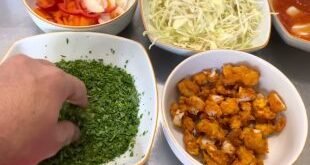Introduction to Romanian Cuisine
Welcome to a culinary journey through the flavors of Romania! Rich in history and tradition, Romanian cuisine is a delightful blend of influences from surrounding countries with a unique twist. Today, we invite you to discover some of the most delicious traditional main dishes that have been passed down through generations. Get ready to tantalize your taste buds with recipes that are sure to transport you straight to the heart of Romania’s vibrant food culture. Let’s dive in and explore the mouthwatering world of Romanian cooking together!
Traditional Romanian Main Dishes: Sarmale (stuffed cabbage rolls), Mici (grilled minced meat rolls), and Ciorbă de Burtă (tripe soup)
When it comes to traditional Romanian main dishes, Sarmale, Mici, and Ciorbă de Burtă are absolute must-tries.
Sarmale is a true comfort food – tender cabbage leaves stuffed with a flavorful mixture of minced meat, rice, and spices. Each bite bursts with savory goodness.
Mici, or grilled minced meat rolls, are popular street food in Romania. Juicy and full of smoky flavor from the grill, they’re perfect for satisfying your cravings on the go.
Ciorbă de Burtă might sound unusual to some, but this tripe soup is a beloved dish in Romanian cuisine. It’s hearty and tangy thanks to sour cream and vinegar.
These dishes have deep roots in Romanian culinary tradition and continue to be cherished by locals and visitors alike for their unique flavors and textures.
How These Dishes Have Evolved Over Time
Romanian traditional main dishes like Sarmale, Mici, and Ciorbă de Burtă have a rich history that dates back centuries. These recipes have evolved over time, influenced by various cultures and culinary traditions.
Sarmale, the beloved stuffed cabbage rolls, were originally made with vine leaves in some regions before transitioning to cabbage due to its abundance in Eastern Europe. Mici, the flavorful grilled minced meat rolls also known as “cevapcici” in other Balkan countries, have been adapted and perfected through generations of family recipes.
Ciorbă de Burtă, the hearty tripe soup once considered peasant food, has now become a staple dish in Romanian cuisine enjoyed by all social classes. As Romania’s culinary landscape continues to evolve with modern influences, these traditional main dishes remain at the heart of every family gathering and festive celebration.
The Ingredients and Techniques Used in Romanian Cooking
Romanian cuisine is a delightful fusion of flavors influenced by various cultures throughout history. The ingredients used in traditional Romanian cooking are simple yet rich, reflecting the country’s agricultural heritage. Staples like pork, beef, potatoes, and cabbage feature prominently in many dishes.
One technique commonly employed in Romanian cooking is slow simmering or stewing to develop deep flavors. This method allows for the melding of spices and ingredients over time, resulting in hearty and comforting meals. Another popular technique is grilling over an open flame, imparting a smoky essence to meats like Mici (grilled minced meat rolls).
Herbs such as dill, parsley, and tarragon add freshness to dishes while sour cream and vinegar provide a tangy contrast. Cornmeal is often used to make polenta – a versatile side dish that pairs well with stews or grilled meats.
The use of fresh ingredients and time-honored techniques contribute to the unique character of Romanian cuisine that continues to captivate food enthusiasts worldwide.
Step-by-Step Recipes for Each Dish
Let’s dive into the step-by-step recipes for these mouthwatering traditional Romanian main dishes. First up, Sarmale, the beloved stuffed cabbage rolls. Begin by preparing a flavorful mixture of minced meat, rice, onions, and spices. Carefully roll this filling into softened cabbage leaves and arrange them snugly in a pot.
Next on the list is Mici, those delicious grilled minced meat rolls. Combine ground beef and pork with garlic, paprika, and other seasonings to form elongated sausages. Grill them over hot coals until perfectly charred on the outside while remaining juicy inside.
And last but not least, Ciorbă de Burtă – tripe soup that packs a punch of flavor. Boil tripe until tender before adding a broth infused with vegetables and sour cream for richness.
These recipes may seem intricate at first glance but follow each step patiently for an authentic taste of Romania’s culinary heritage!
Cultural Significance of These Dishes in Romania
In Romania, traditional dishes like Sarmale, Mici, and Ciorbă de Burtă are more than just meals; they are a reflection of the country’s rich cultural heritage. These recipes have been passed down through generations, each bite carrying stories of family gatherings and festive celebrations.
Sarmale symbolize unity and togetherness as families come together to prepare these labor-intensive cabbage rolls during special occasions. The careful process of rolling the minced meat filling in cabbage leaves is a testament to patience and tradition.
Mici, known as the “Romanian BBQ,” represent community gatherings where friends gather around the grill to enjoy these flavorful minced meat rolls. It’s not just about the food but also about camaraderie and shared moments that create lasting memories.
Ciorbă de Burtă carries on the legacy of using every part of an animal for sustenance. This tripe soup may seem humble but holds a deep-rooted connection to resourcefulness and respect for ingredients among Romanians.
Tips for Authentic Preparation and Serving
Embracing the rich culinary heritage of Romania through its traditional main dishes is a delightful journey that offers a taste of history and culture. By following authentic preparation techniques and using quality ingredients, you can recreate these iconic Romanian recipes in your own kitchen.
Remember to source fresh cabbage, high-quality minced meat, and flavorful herbs for Sarmale. Pay attention to the grilling process when making Mici to achieve that perfect charred exterior while keeping the inside juicy and tender. And don’t forget about the patience required to cook Ciorbă de Burtă – letting the flavors meld together slowly for a truly savory experience.
Whether you are preparing these dishes for a special occasion or simply craving a taste of Romania, taking the time to honor tradition will elevate your dining experience. So gather your loved ones around the table, savor each bite, and celebrate the culinary wonders of Romania with every delicious mouthful. Cheers to good food, great company, and unforgettable flavors!




